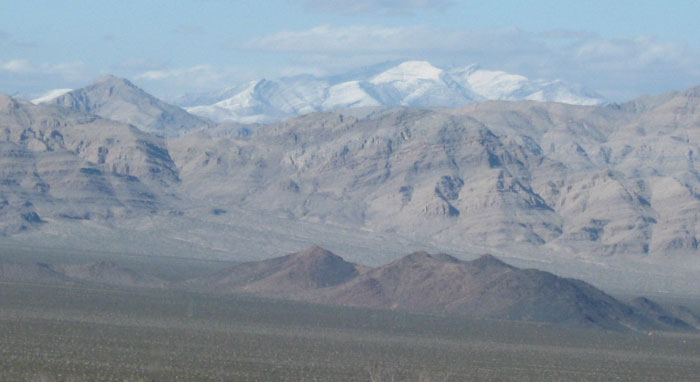^Ivanpah Valley in winter.
Solar Energy Development on Our Public Lands
The Protect Our Communities Foundation kindly allowed us to present their letter in repsonse to the Congressional field hearing in Palm Desert earlier in the month concerning the contentious siting of industrial solar energy projects and their attendant transmission lines in the deserts of California. See our report on this hearing >>here. Their letter follows (the photos of the desert are ours):
May 26, 2009
Congressman Jim Costa
Chairman, Subcommittee on Energy and Mineral Resources
House Natural Resources Energy and Mineral Resources Subcommittee
1324 Longworth House Office Building
Washington, DC 20515
tel: (202) 226-9019
e-mail: Allyson.Groff@mail.house.gov
Subject: The Protect Our Communities Foundation Comment Letter on May 11, 2009 Field Hearing on “Solar Energy Development on Federal Lands: The Road to
Consensus”
Dear Congressman Costa:
Thank you for extending the comment period following the May 11th hearing to allow organizations like The Protect Our Communities (POC) Foundation (www.protectourcommunities.org). POC was unable to send a representative to the hearing and we are grateful for this opportunity to submit comments on use of federal lands for large-scale solar development. POC is a 501(c)(3) non-profit corporation headquartered in San Diego County that began as a grassroots citizen organization three
years ago. The main focus of POC is the energy future of San Diego County and Southern
California. POC fully supports the California Energy Action Plan, developed jointly in 2003 by the California Public Utilities Commission and the California Energy Commission. The Energy Action Plan prioritizes local distributed generation to meet California’s energy needs.
California’s renewable energy approach to date has been almost completely focused on remote renewable energy resources and the transmission associated with such development. Such an approach had merit in the 1980s when California became the world leader in renewable energy and solar panels cost $12 to $15/watt (2008 dollars). However, the world has changed. Commercial solar photovoltaic (PV) installations now cost less than $4/watt.
Nevertheless the Subcommittee on Energy and Mineral Resources appears to accept as a given that large-scale desert solar installations are so much more cost-effective than the urban PV solar alternative that it justifies the transmission cost, environmental trade-offs, and controversy of such desert development. This may have been true in the 1980s. It is not true in 2009.
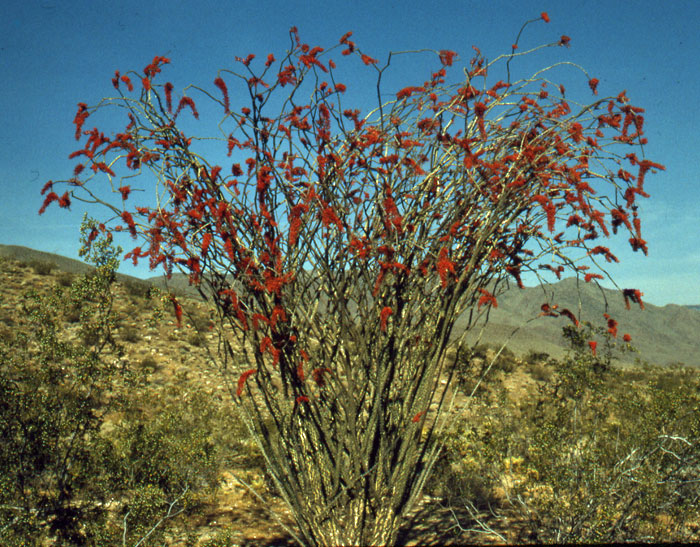
^Ocotillo in bloom, Anza-Borrego Desert State Park, California.
The least-cost solar resource in 2009 is in California’s developed urban and suburban areas, and this resource is vast. All urban solar deployments would be compatible dual-use of existing rooftops and parking lots, avoiding the dilemma you noted in your opening remarks at the hearing – “Solar power is very land-intensive, and siting a solar plant means that most if not all of the other uses of that land are precluded.”
It is true as you noted that “some of the largest (solar) resources are to be found on our public lands.” However, these large solar resources are only useful to the extent they are cost-effective in their own right and can be delivered efficiently to California or Southwestern population centers. As we are discovering through individual transmission line proposals and the Renewable Energy Transmission Initiative (RETI) process, the cost of delivery via new transmission may be astonishingly high, without even addressing the environmental compromises necessary to construct the transmission lines.
The RETI process also revealed that the least-cost solar solution to reaching our target of 33 percent renewable energy by 2020 would consist predominantly of distributed PV. Why? Because state-of-the-art PV is more cost-effective than solar thermal, and tens of thousands of megawatts of PV could be added at the distribution level with little or no upgrading to the existing transmission system required.
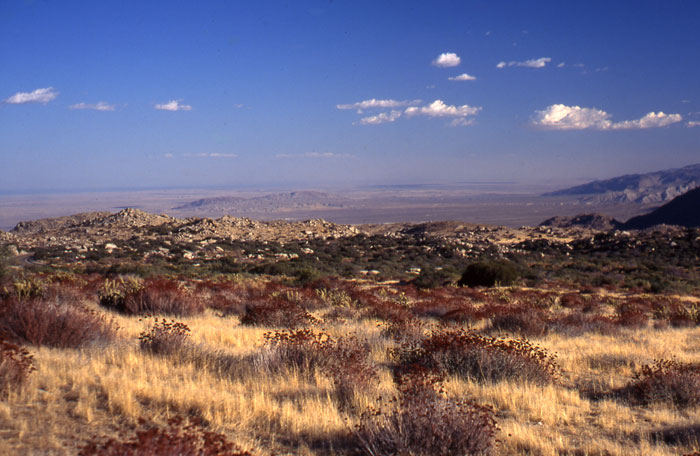
^Giant transmission lines will have to be built across lands like these in the RETI plan: west side of Anaza-Borrego Desert State Park, east of San Diego, California.
The California Energy Commission’s RETI Phase 1B Final Report (January 5, 2009 version)
makes the following points about state-of-the-art PV (pp. 5-27, 5-28):
There is considerable commercial interest in utility-scale “thin film” systems. This sensitivity
tests an alternate thin film technology for solar with capital costs of about $3,700/kWe (AC), roughly half that of tracking crystalline. Notably, these (PV) capital costs are also lower than the large-scale solar thermal projects; therefore thin film solar is assumed to occur both at the distributed scale (20 MW) and also in large scale blocks (150 MW).
Unlike solar thermal technologies, PV can be deployed in urban and suburban areas in
compatible dual-use applications that require no environmental trade-offs. Urban/suburban PV is more cost-effective than remote PV because it avoids the (1) high cost of new transmission lines and (2) high line losses, in the range of 15 percent, during peak demand periods.
The RETI report goes on to say that distributed PV at a current state-of-the-art capital cost of $3,700 per kilowatt can provide two-thirds of what California needs going forward to reach 33 percent by 2020 (p. 5-31):
The results of this sensitivity run are dramatic. More importantly, the cost-competitive in-
state (distributed PV resources) increase by more than 20 times to about 45,000 GWh/yr.
This figure is over two-thirds of the net short requirement. The large majority of these
(distributed) resources are 20 MW solar PV projects assumed to connect to the distribution
system.
In February 2009 RETI reduced its estimate of the gap that must be filled to reach 33 percent by 2020, such that 45,000 GWh/yr from distributed PV could meet 75 percent of the need.
The November 2008 Los Angeles Department of Water & Power (LADWP) “Solar Los
Angeles” strategic plan is a good real-world example of the RETI distributed PV scenario. It consists of 780 megawatts of urban PV and 500 megawatts of remote solar. This is two-thirds urban solar, one-third remote solar. With this urban/remote balance little if any new transmission will be necessary for the City of Los Angeles to go solar. LADWP is a public utility and “Solar Los Angeles” reflects the intent of the City of Los Angeles to become a leader in smart and urban renewable energy development.
San Diego Gas & Electric (SDG&E) service territory offers another example of the large role urban PV could and should play in California’s, and the Nation’s, renewable energy portfolio:
• There is approximately 4,500 megawatts of commercial rooftop and commercial parking
lot PV potential in SDG&E territory;
• Peak load in SDG&E territory in 2008 was 4,348 megawatts, and the average load over
the course of the year is approximately 2,400 megawatts;
• 4,500 megawatts of PV is equivalent to approximately 900 megawatts of continuous
power generation over the course of a year;
• The San Diego area could generate approximately 40 percent of its year-round power
demand from urban commercial rooftop and commercial parking lot PV alone.
• That is without considering approximately 2,500 megawatts of PV potential on
residential rooftops in SDG&E territory;
• If the residential PV resource is fully developed in addition to the commercial PV
resource, 60 percent of the San Diego area’s year-round power demand could be met with urban PV;
• This huge solar resource has no land use requirements, as it is all compatible dual-use,
and has no environmental impacts.
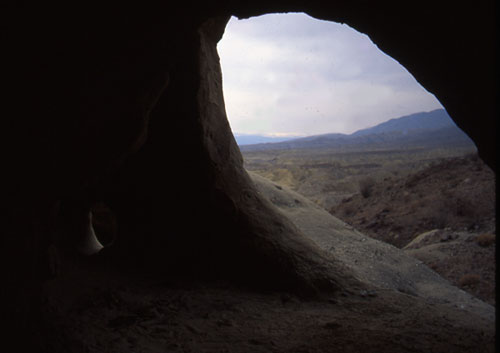
^Wind Caves, Anza-Borrego Desert State Park.
RETI has attempted to sidestep the implications of its oblique endorsement of distributed PV solution to California’s renewable energy goal by stating there is no way PV manufacturers could mobilize quickly enough to provide 2,000 to 3,000 megawatts of PV per year to realize the potential of the distributed PV scenario. This is not a valid concern. Spain, with about the same population as California and a less productive economy, added nearly 2,500 megawatts of PV in 2008. More than 5,000 megawatts of PV was installed worldwide in 2008. A POC representative attended the 1st Thin-Film PV Summit in San Francisco in early December 2008. Statistics on worldwide PV manufacturing capacity were presented at the Summit. Worldwide thin-film PV production capacity reached 3,600 megawatts per year in 2008. It is projected to reach 7,400 megawatts per year in 2010. Worldwide conventional polycrystalline silicon PV production capacity reached 13,300 megawatts per year in 2008. It is projected to reach 20,000 megawatts per year in 2010. There will be some scale-back on the 2010 capacity numbers due to the state of
the world economy.
Worldwide PV manufacturing, either thin-film alone or thin-film and conventional
polycrystalline silicon, could readily supply a 3,000 megawatts per year PV demand in
California and much higher PV demand for the U.S. as a whole. The Wall Street Journal recently reported that conventional solar panel prices have fallen by $2/watt since 2008, due to too much solar manufacturing capacity chasing too few solar projects. It is disingenuous of RETI to dismiss the distributed PV solution on grounds of PV manufacturing capacity constraints.
POC views the emphasis on new transmission as necessary precursor to substantial progress on renewable energy goals as a testament to very effective lobbying by America’s investor-owned utilities (IOUs). The IOUs have for the moment successfully adapted a critical new problem, climate change, to a century-old revenue generation scheme.
IOUs make far more profit on transmission lines than any other types of infrastructure they build. For example, SDG&E’s proposed 1,000 MW Sunrise Powerlink transmission line, with an estimated cost of $1.9 billion, will generate at least $1.3 billion in profits (in current dollars) for SDG&E shareholders over the financial life of the project. $700 million of those profits will be credited to the company in the first eight-and-a-half years. Remote renewable energy generation requires transmission. Local renewable energy generation does not.
The nation has over 527,000 miles of existing high voltage transmission. See Figure 1. This transmission infrastructure serves a declining demand for electricity. U.S. electricity demand declined approximately 2 percent in 2008 and is expected to decline another 1 percent in 2009.
Southern California, with an average electrical demand of approximately 14,000 megawatts, has approximately 20,000 megawatts of import capacity on existing transmission lines. See Figure 2. Southern California can already import 100 percent of its average electrical load. There may be some need to upgrade older lines so they can continue to provide decades of reliable service. However, neither California nor the Nation is experiencing a shortage of transmission as a general matter.
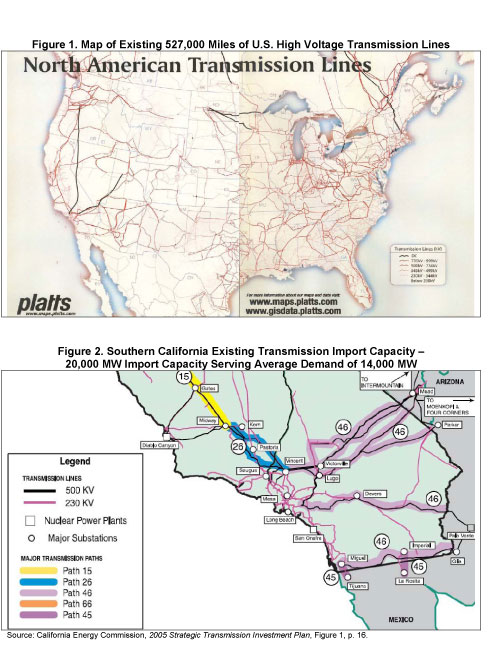
The policy challenge is the difficult work of ramping down the existing flow of fossil power on these lines and methodically replacing it with renewable energy generation. A reasonable proposal of this sort was presented to the California Energy Commission in early 2007 by, Solar Millenium, a major solar thermal developer. Called the Mojave Solar Development Zone, it would preferentially locate solar thermal projects along the right-of-ways of major existing highways with existing high voltage transmission lines in the Mojave Desert. These highway corridors already have a combined 6,000 megawatts of existing transmission capacity.
Figure 3 shows the corridors identified by Solar Millenium for inclusion in its proposed Mojave Solar Development Zone. In reality the zone identified by Solar Millenium is far larger than it needs to be to generate 6,000 megawatts or even 10,000 megawatts of solar power. Solar thermal or PV can produce about 100 megawatts per square mile. One hundred square miles would produce about 10,000 megawatts. One-half mile solar right-of-ways on each side of the highway for only 100 miles of the 100s of highway miles shown on the Solar Millenium map would suffice to provide 10,000 megawatts of solar power.
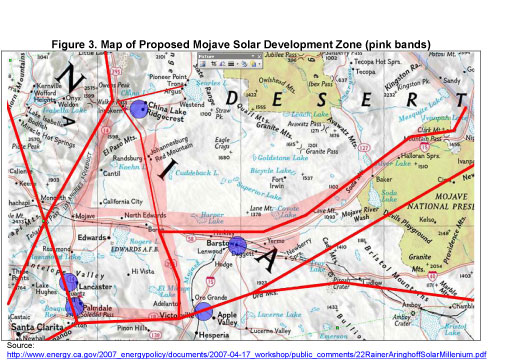
This commonsense proposal pre-dates the RETI process and apparently gained little or no
traction within the RETI process itself. One likely reason is that the solar land rush had already begun, and restricting solar develop to a limited Mojave Solar Development Zone would have inconvenienced developers with more remote and undeveloped properties in some phase of negotiation. Another likely reason is that it made use of existing transmission and presumed that existing fossil transmission rights would be transferred to the solar projects. This is a reasonable presumption, but is also a strategy the IOUs have steadfastly opposed. The California Energy Commission and the state of California missed a golden opportunity in 2007 to gain some control of the desert land rush through some form of the Mojave Solar Development Zone and failed to act.
The easiest pathway from a political standpoint, to give the IOUs a mandate to overlay public lands and the Nation with new transmission, will result in tremendous controversy and probable gridlock in moving forward on the development of renewable generation. The affected citizens and interest groups will oppose many of these projects for the right reasons – that there are better, more cost-effective, and less damaging solutions that are being ignored or dismissed for reasons of political convenience.
It is understandable why an IOU would see renewable energy solutions through a transmission lens. However, that lens is costly, inefficient, controversial, and damaging. The fact that a solar strategy with heavy reliance on new transmission would be very costly is positive financial news to an IOU. The more the new transmission system costs, the more the IOUs will thrive economically. Yet it is an unnecessary and largely avoidable financial burden on everyone else. The Subcommittee on Energy and Mineral Resources should not reflexively adopt today’s IOU financial reward system as the point-of-departure for crafting the nation’s solar energy development policy on public lands.
POC believes that you and all members of the Subcommittee on Energy and Mineral Resources genuinely want to address climate change. POC is glad for this opportunity to provide input about the most efficient way to achieve that end. We do believe that, when we put all the costs on the table, there is no question that urban solar should be the centerpiece of our solar strategy and not an afterthought.
POC looks forward to continuing to work with the Subcommittee on Energy and Mineral
Resources to maximize solar energy production in the most cost-efficient and environmentally sound manner.
Sincerely,
Denis Trafecanty, President
The Protect Our Communities Foundation
PO Box 305
Santa Ysabel, CA 92070
Bill Powers, P.E., POC Board Member
Powers Engineering
San Diego
cc:
Sen. Dianne Feinstein
Sen. Barbara Boxer
Sen. Harry Reid
Sen. Jeff Bingaman
Congressman Nick Rahall
Congressman Henry Waxman
Congressman Ed Markey
Congressman Bob Filner
Congresswoman Susan Davis
Congressman Duncan Hunter, Jr.
Interior Secretary Henry Salazar
DOE Secretary Steven Chu
EPA Administrator Lisa Jackson
Gov. Arnold Schwarzenegger
Carl Pope, Sierra Club
Frances Beinecke, NRDC
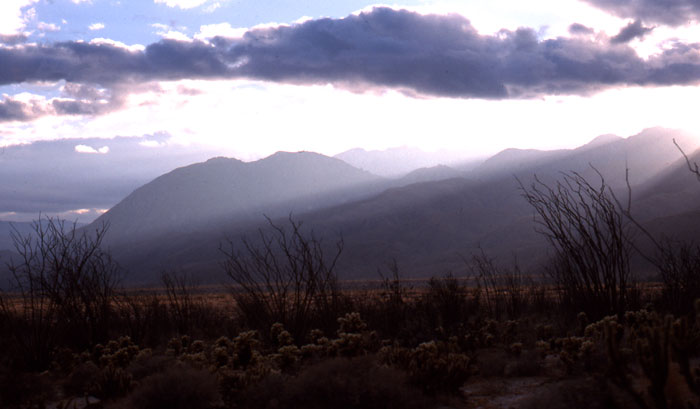
^Ocotillo and Teddybear cholla at Borrego Springs, Anza-Borrego Desert State Park.
HOME..........Palm Desert Hearing on Siting Solar Projects on Federal Lands
Ivanpah Solar Electric Generating Project.....Last Spring at Ivanpah?
Sunrise Powerlink (The Desert Protective Council).....Protect Our Communities Foundation
